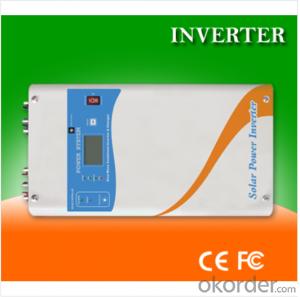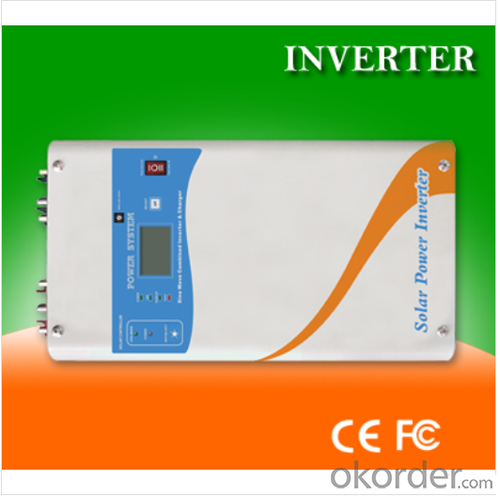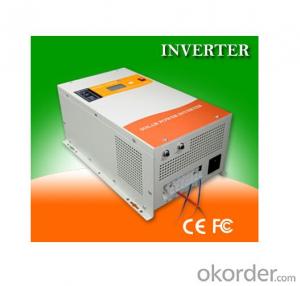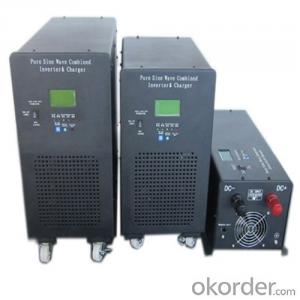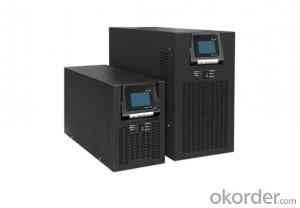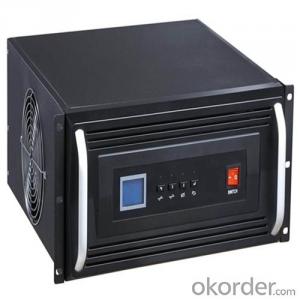Phocos Solar Inverter - Pure Sine Wave Inverter with MPPT Controller 1000W, 2000W, 3000W
- Loading Port:
- Qingdao
- Payment Terms:
- TT OR LC
- Min Order Qty:
- 50000 watt
- Supply Capability:
- 3000000 watt/month
OKorder Service Pledge
OKorder Financial Service
You Might Also Like
1. Structure of Pure Sine Wave Inverter with Mppt Controller 1000w 2000w 3000w Description
A solar inverter, or PV inverter, or Solar converter, converts the variable direct current (DC) output of a photovoltaic (PV) solar panel into a utility frequency alternating current (AC) that can be fed into a commercial electrical grid or used by a local, off-grid electrical network. It is a critical BOS–component in a photovoltaic system, allowing the use of ordinary AC-powered equipment. Solar inverters have special functions adapted for use with photovoltaic arrays, including maximum power point tracking and anti-islanding protection.
2. Main Features of the Pure Sine Wave Inverter with Mppt Controller 1000w 2000w 3000w
﹒Pure sine-wave out put,can be used with different domestic appliance TV,Refrigerator,Fan,Air conditioner ,Induction cooker,micro-wave oven etc.
﹒ Generator compatibly and external battery connection achievable.
3. Pure Sine Wave Inverter with Mppt Controller 1000w 2000w 3000w Images
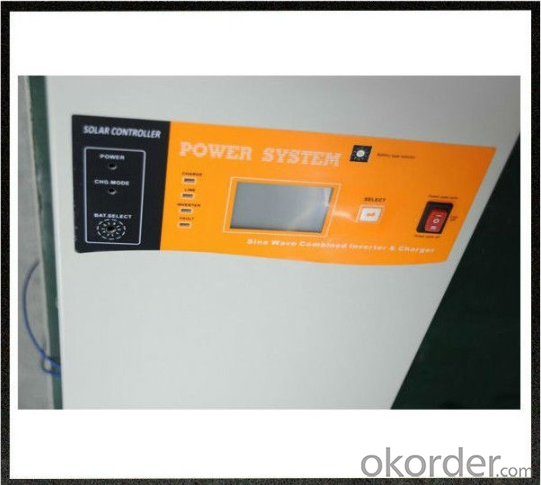
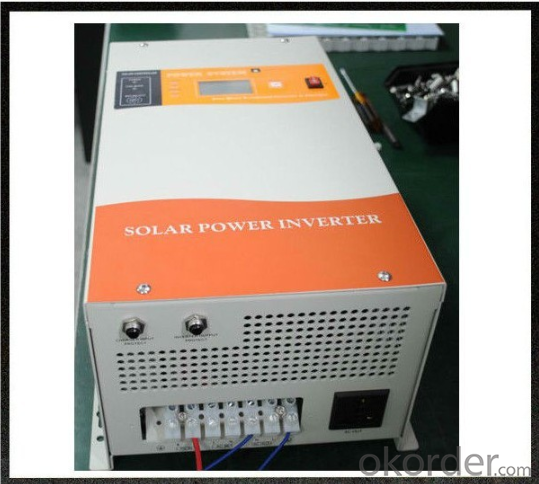
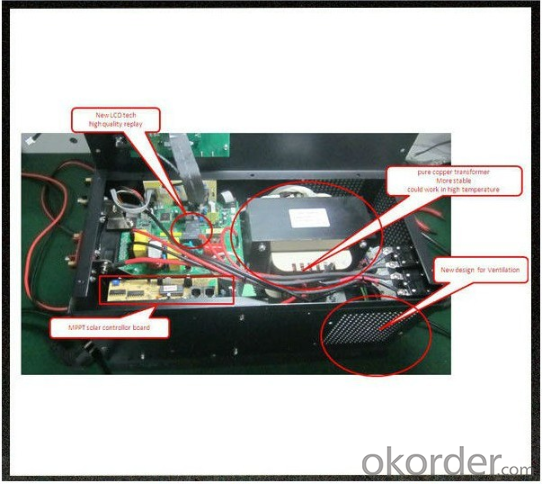
4. Pure Sine Wave Inverter with Mppt Controller 1000w 2000w 3000w Specification
Hybrid Inverter | ||
MPPT solar controller function | ||
Rated Voltage | 12/24V DC | |
Rated Charge current | 40A | |
Load current | 15A | |
Input voltage range | 15-55V DC | |
Max. PV open circuit array voltage | 55V DC | |
Typical idle consumption | At idle< 10mA | |
Overload protection(DC load) | 2.0*Inom>5s 1.5*Inom>20s 1.25*Inom temperature controlled | |
Bulk charge | 14.6V(default) | 29.2V(default) |
Floating charge | 13.4V(default) | 26.8V(default) |
Equalization charge | 14.0V(default) | 28.0V(default) |
Over charge disconnection | 14.8V | 29.6V |
Over charge recovery | 13.6V | 27.2V |
Over discharge disconnection | 10.8V(default) | 21.6V(default) |
Over discharge reconnection | 12.3V | 24.6V |
Temperature compensation | 13.2mV/C | 26.4mV/C |
Lead acid battery settings | Adjustable | |
NiCad battery settings | Adjustable | |
Load control mode | 1.Low Voltage Reconnect(LVR):Adjustable 2.Low Voltage Disconnect(LVD):Automatic disconnection 3.Reconnection:Includes warning flash before disconnect and reconnection | |
Low voltage reconnect | 12.0-14.0Vdc | 24.0-28.0Vdc |
low voltage disconnet | 10.5-12.5Vdc | 21.0-25.0Vdc |
Ambient temperature | 0-40°C(full load) 40-60°C(de-rating) | |
Altitude | Operating5000m,Non-Operating 16000m | |
Protection class | IP21 | |
Battery temperature sensor | BTS-optional remote battery temperature sensor for increased charging precision | |
Terminal size(fine/single wire) | #8 AWG | |
PV inverter battery priority | |||||||
MODEL | 1000w | 1500w | 2000w | 3000w | |||
Input Voltage Waveform | Sinusoidal (utility or generator) | ||||||
Nominal Input Voltage | 230Vac | ||||||
Low Line Disconnect | 155Vac±4% | ||||||
High Line Disconnect | 265Vac±4% | ||||||
Max AC Input Voltage | 270Vrms | ||||||
Nominal Input Frequency | 50Hz/ 60Hz (Auto detection) | ||||||
Over-Load Protection | Circuit breaker | ||||||
Output Short Circuit Protection | Circuit breaker | ||||||
Efficiency (Line Mode) | >95% | ||||||
Transfer Switch Rating | 30A | ||||||
Transfer Time(Ac to Dc) | 20ms (typical) | ||||||
Output Voltage Waveform | Sine wave | ||||||
Rated Output Power (W) | 1000W | 1500W | 1500W | 2000W | 2000W | 3000W | 3000W |
Power Factor | 1 | ||||||
Nominal Output Voltage (V) | 230Vac | ||||||
Output Voltage Regulation | ±10% rms | ||||||
Nominal Efficiency | >80% | ||||||
Nominal DC Input Voltage | 12V | 12V | 24V | 12V | 24V | 12V | 24V |
Nominal Charge Current | 35A | 45A | 35A | 65A | 35A | 75A | 45A |
Charge Current Regulation | ± 5A | ||||||
Battery initial voltage | 0 –15.7 Vdc /31.4Vdc(can operate with 0V battery) | ||||||
Communication: | RJ11 (Used for factory testing. No customer interface available) | ||||||
Safety Certification | CE(EN60950) | ||||||
EMI Classification | EN50091-2, CLASS A | ||||||
Operating Temperature Range | 0°C to 40°C | ||||||
Storage temperature | -15ºC ~ 60ºC | ||||||
Operation humidity | 5% to 95% | ||||||
Audible Noise | 60dB max | ||||||
Cooling | Forced air, variable speed fan | ||||||
5. FAQ of Pure Sine Wave Inverter with Mppt Controller 1000w 2000w 3000w
Q1. What is the difference between inverter and solar inverter?
A1. Inverter only has AC inpput, but solar inverter both connect to AC input and solar panel, it saves more power.
Q2. What is the difference between MPPT&PWM?
A2. MPPT has higher efficiency, it can track the max power point and won't waste energy.
Q3. What is the waranty of product?
A3. 12 months.
- Q: How does a solar inverter communicate with other components of a solar power system?
- A solar inverter communicates with other components of a solar power system through various means, such as wired or wireless connections. It typically exchanges information with components like solar panels, batteries, and grid-tie systems to coordinate and optimize the generation, storage, and distribution of solar energy. This communication includes exchanging data on power output, voltage levels, and system status, enabling efficient operation and monitoring of the entire solar power system.
- Q: Are there any limitations on the number of solar panels that can be connected to a single inverter?
- Yes, there are limitations on the number of solar panels that can be connected to a single inverter. The maximum number of panels that can be connected depends on various factors such as the power rating of the inverter, the voltage and current ratings of the panels, and the configuration of the system. In general, the inverter should be able to handle the combined power output of all the connected solar panels. If the panels generate more power than the inverter can handle, it may lead to system inefficiencies, reduced performance, or even damage to the inverter. Additionally, the voltage and current ratings of the panels should be within the acceptable range of the inverter. If the panels have a higher voltage or current rating than what the inverter can safely handle, it may result in overloading or malfunctioning of the inverter. Furthermore, the configuration of the solar panels also plays a role in determining the limitations. Panels can be connected in series or parallel, and each configuration has its own requirements and limitations. The inverter needs to be compatible with the specific configuration being used. To ensure proper functioning and optimal performance, it is recommended to consult the manufacturer's guidelines and specifications for both the solar panels and the inverter. These guidelines will provide information on the maximum number of panels that can be connected to a single inverter and any other specific limitations or requirements that need to be considered.
- Q: Can a solar inverter be used with different types of power factor correction devices?
- Yes, a solar inverter can be used with different types of power factor correction devices. Power factor correction devices are designed to improve the power factor of electrical systems and reduce reactive power. Solar inverters convert the DC power generated by solar panels into AC power that can be used in the electrical system. The power factor correction devices can be installed in conjunction with the solar inverter to improve the overall power factor of the system and enhance its efficiency.
- Q: How does a solar inverter handle voltage fluctuations in the grid?
- A solar inverter handles voltage fluctuations in the grid by continuously monitoring the grid voltage. When the voltage deviates from the standard range, the inverter adjusts its output accordingly to stabilize the voltage and ensure a consistent supply of power.
- Q: How does a solar inverter synchronize with the electrical grid?
- A solar inverter synchronizes with the electrical grid through a process called grid synchronization. This involves the inverter constantly monitoring the voltage and frequency of the grid and adjusting its own output accordingly to match the grid's parameters. Once the inverter's output matches the grid's voltage and frequency, it can seamlessly feed the solar-generated electricity into the grid, ensuring safe and efficient integration of solar power into the existing electrical infrastructure.
- Q: How does a solar inverter handle excess power production?
- A solar inverter handles excess power production by converting the surplus electricity generated by the solar panels into AC power, which can then be either used in the household or fed back into the grid for others to use.
- Q: How does a solar inverter communicate with other system components?
- A solar inverter communicates with other system components through various methods such as wired connections, wireless technologies, and communication protocols. It can be connected to the energy management system or smart grid through Ethernet cables or Wi-Fi for data exchange and control. Additionally, it may use communication protocols like Modbus or SunSpec to transmit information to monitoring devices, batteries, or other renewable energy sources within the system.
- Q: How does a solar inverter handle voltage fluctuations?
- A solar inverter handles voltage fluctuations by constantly monitoring the input voltage from the solar panels and adjusting its output voltage accordingly. It maintains a stable output voltage even when there are fluctuations in the input voltage, ensuring that the electricity generated by the solar panels is suitable for use in the electrical grid or for powering appliances.
- Q: How do you choose the right size of solar inverter for a system?
- When choosing the right size of solar inverter for a system, it is important to consider the total capacity of the solar panels and the expected power output. The inverter should have a capacity that matches or slightly exceeds the maximum power output of the panels to ensure optimal efficiency. Additional factors such as the type of grid connection and any future expansion plans should also be taken into account. Consulting with a professional solar installer or conducting a thorough system assessment can help determine the appropriate size of the inverter for a given solar system.
- Q: How does a solar inverter handle voltage flicker in the grid?
- A solar inverter handles voltage flicker in the grid by employing various control mechanisms. It continuously monitors the grid voltage and adjusts its own output accordingly to compensate for any fluctuations or flickering. By dynamically regulating its power output, the solar inverter helps stabilize the grid voltage and mitigate the impact of voltage flicker, ensuring a stable and reliable power supply.
Send your message to us
Phocos Solar Inverter - Pure Sine Wave Inverter with MPPT Controller 1000W, 2000W, 3000W
- Loading Port:
- Qingdao
- Payment Terms:
- TT OR LC
- Min Order Qty:
- 50000 watt
- Supply Capability:
- 3000000 watt/month
OKorder Service Pledge
OKorder Financial Service
Similar products
Hot products
Hot Searches
Related keywords
